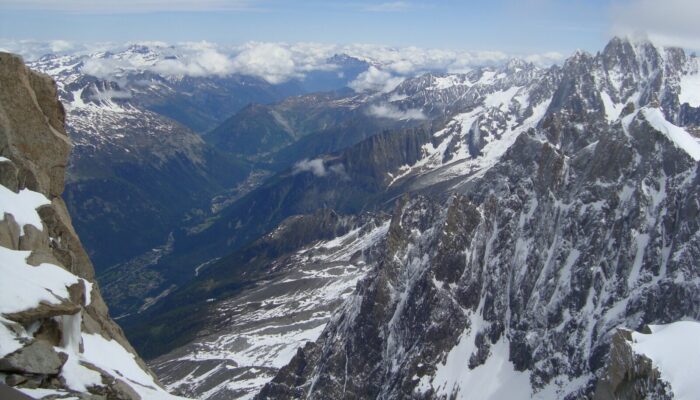
On July 16, 1965, the Mont Blanc Tunnel, 11.611 km of tunnel piercing the heart of the Alps, opened to traffic, marking a triumph of engineering, geology, and international cooperation. Sixty years later, this civilian artery connecting Chamonix (France) and Courmayeur (Italy) stands not just as a testament to human inventiveness but as an ongoing marvel if viewed through a geoscientific lens.
On this anniversary, I’m writing this blog to explore the journey of Mont Blanc and dig into the tunnel’s construction, challenges, scientific significance, and its enduring impact on rock mechanics, groundwater hydrology, tunnel safety, and even environmental monitoring.
Alpine geology and fault architecture
At its heart, the Mont Blanc massif exposes a vast Variscan granite batholith (protogine) intruded into a gneiss and mica schist basement, later reactivated during Alpine orogeny. The summit lies near the granite–schist boundary, marking a complex structural interface shaped by multiple tectonic phases. This lithological complexity directly influenced the tunnel’s trajectory: one branch penetrated massive granite, the other was charted through sheared schists and fault zones.
The tunnel alignment intersects a faulted contact zone; on the French side, engineers encountered this structural transition some 3.2 km from the portal, a zone of elevated fracturing and hydrothermal alteration spanning approximately 400 m. The abrupt change from massive granite to geoporphyritic protogine with overprinting mylonitic shears demanded continuous geotechnical logging and adaptive excavation practices.
Rock mechanics:
Full-face excavation within such heterogeneous, deep rock masses represented a methodological innovation in hard-rock tunnelling. The Mont Blanc project, under immense rock overburden (up to ~2,480 m), became a pioneering case study in high-stress response behaviour under excavation. Borehole strain measurements during construction revealed significant stress path deviations and mobilized decompression cracking and rock bursts. These phenomena necessitated a dense support infrastructure, including around 180,000 rock bolts, reinforced concrete linings, and steel mesh, to resist spalling. Underlying this practice were foundational tenets of rock mechanics: brittle failure under high deviatoric stress, fracture propagation, and the critical role of rock anisotropy.
Beyond construction era observations, modern studies in rock mechanics have refined our understanding. The process of dilatancy-related failure shows that unstable crack growth may be arrested by transient pore-pressure drops, a mechanism particularly relevant in crystalline, fluid-saturated rock masses. Such dynamics help explain the intermittent cracking and gradual strain release observed during excavation and during episodic drainage events in the tunnel.
Subterranean waters and airflow dynamics:
Drilling the Mont Blanc Tunnel did more than just break through hard rock: it opened up a previously hidden network of mountain springs. Engineers were surprised to find water up to about 26.5 °C, showing that deep underground channels were carrying heat upward. The water’s slightly basic pH of around 8.5 and low mineral content told them it hadn’t been underground for long. By using naturally occurring markers like oxygen‑18 and tritium isotopes, researchers traced these fast pathways: some fractures delivered melted snow to tunnel level in just a few months, while others took many years, which divulges how unevenly water moves through solid rock.
Temperature measurements along the tunnel walls weren’t just curiosities: by linking sudden warm spots to higher flow rates, teams could predict where water would burst in before they ever broke through. In other words, they used it to shore up the tunnel safely, not only under Mont Blanc but also in similar projects like the Simplon Tunnel.
But water was only half the tale, while air was the other. At depths nearing 2,500 m under granite, tunnel heat (and occasional brake fires) risked turning drivers into unwilling sauna‑goers. A transverse ventilation scheme, with fresh‑air ducts every 10 m, exhaust vents every 100 m, and reversible axial jet fans, became essential to maintain breathable, temperate conditions. Modern 1‑D thermo‑fluid models now simulate airflow patterns and heat exchange so accurately that even the hottest underground topics stay nice and cool.
From tragedy to triumph: safety reinvention and a living laboratory
The 1999 Mont Blanc fire was a pivot point: 39 lives lost and international outrage compelled a full safety overhaul. Today’s tunnel features centralized control rooms, continuous‑monitoring sensors, cross‑passage escape galleries, automated fire barriers, and stringent tunnel‑fire drills. What began as a sombre lesson in “blowing hot air” safety (the ventilation system’s job of moving air that can become heated by vehicle engines, brake friction, or even fires.
The 1999 fire revealed that simply ventilating fumes and heat wasn’t sufficient to keep people safe and forced engineers and authorities to rethink every aspect of tunnel safety.) has evolved into a state‑of‑the‑art resilience system. This latter comprises of advanced fire detection, thermographic gates to check engines overheating, automated smoke management, cross-passages for evacuation, centralized control rooms, real-time monitoring, and even a thermometric cable equipped with 3680 sensors running the full length of the tunnel to detect the temperature in the tunnel continuously every 25 metres!
Beyond human protection, the tunnel doubles as a mountain observatory for Alpine hydrogeology and rock‐mass behavior. In fact, Jean‑Christophe Maréchal’s 2011 presentation even calls it an “exemple d’observatoire alpin des eaux souterraines,” because every inflow encountered during construction and operation has been carefully measured and characterized to reveal deep groundwater pathways and fracture‐dependent flow rates
Perhaps most enduring is Mont Blanc’s academic impact. Innovations in overcoring for in situ stress measurements, refined isotope‑tracer hydrogeology models, coupled thermo‑hydraulic analyses, and advanced ventilation CFD all trace their lineage to this Alpine artery. Research teams still pore over decades of Mont Blanc data: from rock mechanics insights, fracture flow dynamics, to airflow optimizations, to inform every new deep‑bore project. In engineering, Mont Blanc is the ultimate “case study” as it proves that when you tunnel through a mountain of challenges, you unearth a treasure trove of scientific knowledge!

